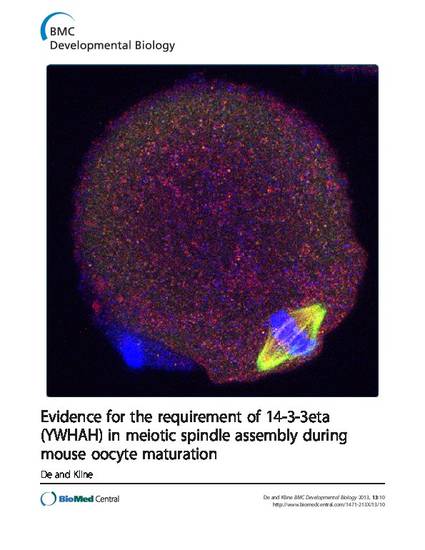
- Meiosis,
- Oocyte maturation,
- 14-3-3η,
- Meiotic spindle,
- Morpholino oligonucleotide,
- α-tubulin
Background
The 14-3-3 (YWHA) proteins are central mediators in various cellular signaling pathways regulating development and growth, including cell cycle regulation. We previously reported that all seven mammalian 14-3-3 isoforms are expressed in mouse oocytes and eggs and that, 14-3-3η (YWHAH) accumulates and co-localizes in the region of meiotic spindle in mouse eggs matured in vivo. Therefore, we investigated the role of 14-3-3η in spindle formation during mouse oocyte maturation. Results
Examination of oocytes matured in vitro demonstrated that 14-3-3η accumulates in both meiosis I and II spindles. To explore if 14-3-3η interacts directly with α-tubulin in meiotic spindles, we performed an in situ proximity ligation assay that can detect intracellular protein-protein interactions at the single molecule level and which allows visualization of the actual interaction sites. This assay revealed a marked interaction between 14-3-3η and α-tubulin at the metaphase II spindle. To demonstrate a functional role for 14-3-3η in oocyte maturation, mouse oocytes were microinjected with a translation-blocking morpholino oligonucleotide against 14-3-3η mRNA to reduce 14-3-3η protein synthesis during oocyte maturation. Meiotic spindles in those cells were examined by immunofluorescence staining of 14-3-3η and α-tubulin along with observation of DNA. In 76% of cells injected with the morpholino, meiotic spindles were found to be deformed or absent and there was reduced or no accumulation of 14-3-3η in the spindle region. Those cells contained clumped chromosomes, with no polar body formation. Immunofluorescence staining of 14-3-3η and α-tubulin in control eggs matured in vitro from uninjected oocytes and oocytes microinjected with the ineffective, inverted form of a morpholino against 14-3-3η, a morpholino against 14-3-3γ, or deionized water showed normal, bipolar spindles. Conclusions
The results indicate that 14-3-3η is essential for normal meiotic spindle formation during in vitro maturation of mouse oocytes, in part by interacting with α-tubulin, to regulate the assembly of microtubules. These data add to our understanding of the roles of 14-3-3 proteins in mouse oocyte maturation and mammalian reproduction.
Available at: http://works.bepress.com/santanu-de/3/

© De and Kline; licensee BioMed Central Ltd. 2013
This article is published under license to BioMed Central Ltd. This is an Open Access article distributed under the terms of the Creative Commons Attribution License (http://creativecommons.org/licenses/by/2.0), which permits unrestricted use, distribution, and reproduction in any medium, provided the original work is properly cited.